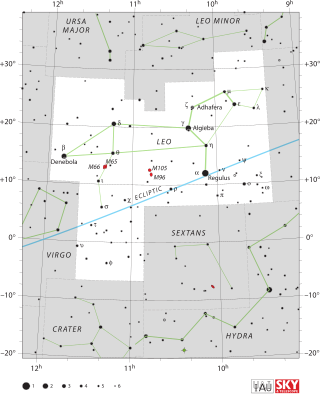
Leo is one of the constellations of the zodiac, between Cancer the crab to the west and Virgo the maiden to the east. It is located in the Northern celestial hemisphere. Its name is Latin for lion, and to the ancient Greeks represented the Nemean Lion killed by the mythical Greek hero Heracles as one of his twelve labors. Its old astronomical symbol is (♌︎). One of the 48 constellations described by the 2nd-century astronomer Ptolemy, Leo remains one of the 88 modern constellations today, and one of the most easily recognizable due to its many bright stars and a distinctive shape that is reminiscent of the crouching lion it depicts.

The Whirlpool Galaxy, also known as Messier 51a (M51a) or NGC 5194, is an interacting grand-design spiral galaxy with a Seyfert 2 active galactic nucleus. It lies in the constellation Canes Venatici, and was the first galaxy to be classified as a spiral galaxy. It is 7.22 megaparsecs away and 23.58 kiloparsecs (76,900 ly) in diameter.
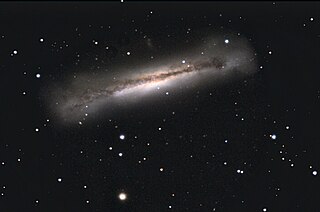
NGC 3628, also known as the Hamburger Galaxy or Sarah's Galaxy, is an unbarred spiral galaxy about 35 million light-years away in the constellation Leo. It was discovered by William Herschel in 1784. It has an approximately 300,000 light-years long tidal tail. Along with M65 and M66, NGC 3628 forms the Leo Triplet, a small group of galaxies. Its most conspicuous feature is the broad and obscuring band of dust located along the outer edge of its spiral arms, effectively transecting the galaxy to the view from Earth.
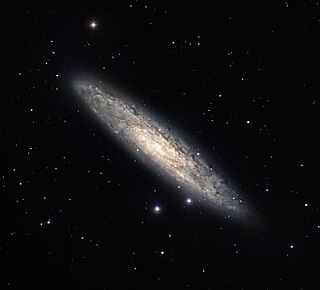
The Sculptor Galaxy is an intermediate spiral galaxy in the constellation Sculptor. The Sculptor Galaxy is a starburst galaxy, which means that it is currently undergoing a period of intense star formation.

NGC 5078 is a spiral galaxy in the Hydra constellation, approximately 94 million light-years away from Earth. It has a diameter of 127,000 light-years and is probably a member of the NGC 5061 group. The dust lane of NGC 5078 is warped, probably by interaction with the nearby galaxy IC 879, which is itself distorted into an 'S' shape by the interaction. At the presumed distance the two galaxies would have a minimal separation of about 61,000 light-years. For comparison, the Large Magellanic Cloud is about 160,000 light-years from the Milky Way.

NGC 3370 (also known as UGC 5887 or Silverado Galaxy) is a spiral galaxy about 82.2 ± 5.9 million light-years (25.2 ± 1.8 megaparsecs) away in the constellation Leo. It is nearly comparable to our Milky Way both in diameter with a D25 isophotal size about 77,300 ly (23.69 kpc) comparing to the Milky Way Galaxy's 87,400 ly (26.8 kpc) diameter, and as well as in mass (1011 M☉). NGC 3370 exhibits an intricate spiral arm structure surrounding a poorly defined nucleus. It is a member of the NGC 3370 Group of galaxies, which is a member of the Leo II Groups, a series of galaxies and galaxy clusters strung out from the right edge of the Virgo Supercluster.

NGC 2683 is a field spiral galaxy in the northern constellation of Lynx. It was nicknamed the "UFO Galaxy" by the Astronaut Memorial Planetarium and Observatory. It was discovered by the astronomer William Herschel on February 5, 1788.
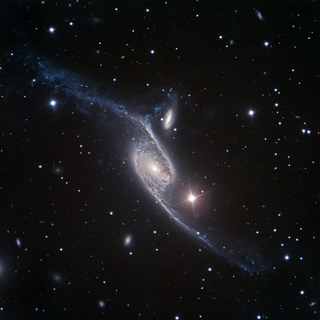
NGC 6872, also known as the Condor Galaxy, is a large barred spiral galaxy of type SB(s)b pec in the constellation Pavo. It is 212 million light-years (65 Mpc) from Earth. NGC 6872 is interacting with the lenticular galaxy IC 4970, which is less than one twelfth as large. The galaxy has two elongated arms with a diameter based on ultraviolet light of over 522,000 light-years (160,000 pc), and a D25.5 isophotal diameter of over 717,000 light-years (220,000 pc), making it the largest known spiral galaxy. It was discovered on 27 June 1835 by English astronomer John Herschel.
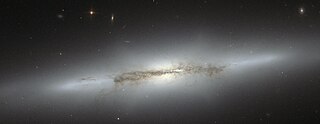
NGC 4710 is an edge-on lenticular galaxy in the northern constellation of Coma Berenices. It was discovered on March 21, 1784 by German-British astronomer William Herschel. This galaxy has a B-band visual magnitude of 11.60 and an angular size of 3.0′ × 0.8′. It is located at a distance of 54.5 ± 3.6 million light-years (16.7 ± 1.1 Mpc) from the Milky Way, and is receding with a heliocentric radial velocity of 1,129 km/s. This is a member of the Virgo Cluster, with a projected offset of ~6° from the cluster center and a cluster crossing time of around two billion years.

NGC 5364 is a grand design spiral galaxy located 54.5 million light years away in the constellation Virgo. It is inclined to the line of sight from the Earth at an angle of 47° along a position angle of 25°. It is a member of the NGC 5364 Group of galaxies, itself one of the Virgo III Groups strung out to the east of the Virgo Supercluster of galaxies.
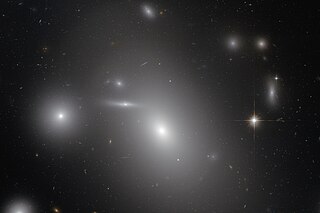
NGC 4889 is an E4 supergiant elliptical galaxy. It was discovered in 1785 by the British astronomer Frederick William Herschel I, who catalogued it as a bright, nebulous patch. The brightest galaxy within the northern Coma Cluster, it is located at a median distance of 94 million parsecs from Earth. At the core of the galaxy is a supermassive black hole that heats the intracluster medium through the action of friction from infalling gases and dust. The gamma ray bursts from the galaxy extend out to several million light years of the cluster.

NGC 24 is a spiral galaxy in the southern constellation of Sculptor, about 23.8 megalight-years distant from the Milky Way. It was discovered by British astronomer William Herschel in 1785, and measures some 40,000 light-years across. The general shape of this galaxy is specified by its morphological classification of SA(s)c, which indicates it is an unbarred spiral with no ring-like structure and moderate to loosely-wound spiral arms. This galaxy is positioned in the vicinity of the Sculptor Group, but is actually a background object that is more than three times as distant. It may form a pair with another background galaxy, NGC 45.

NGC 7332 is an edge-on peculiar lenticular galaxy located about 67 million light-years away in the constellation Pegasus. It possesses a -shaped bulge, associated with stellar bar. It was discovered on September 19, 1784 by the astronomer William Herschel.

NGC 125 is a lenticular galaxy located in the constellation Pisces. It is designated as subclass Sa Ring in the galaxy morphological classification scheme. It lies approximately 235 million light-years away.

NGC 596 is an elliptical galaxy in the constellation Cetus. The galaxy lies 65 million light years away from Earth, which means, given its apparent dimensions, that NGC 596 is approximately 60,000 light years across. The galaxy shows an outer envelope and is a merger remnant. The surface brightness profil is smooth and featureless. The galaxy hosts a supermassive black hole, whose mass is estimated to be 170 million (108.24) .
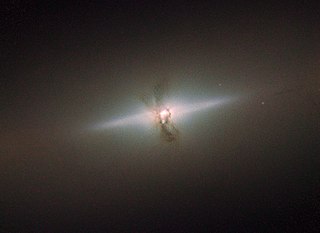
NGC 4111 is a lenticular galaxy in the constellation Canes Venatici. It is located at a distance of circa 50 million light-years from Earth, which, given its apparent dimensions, means that NGC 4111 is about 55,000 light-years across. It was discovered by William Herschel in 1788. NGC 4111 possesses both thin and thick discs.
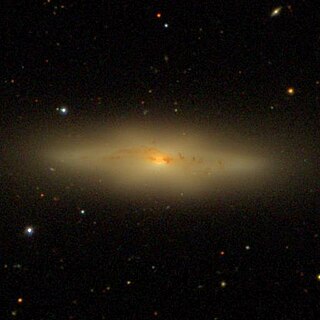
NGC 4469 is a nearly edge-on spiral galaxy located about 55 million light-years away in the constellation of Virgo. It is also classified as a LINER galaxy. NGC 4469 was discovered by astronomer William Herschel on April 15, 1784. It is a member of the Virgo Cluster.
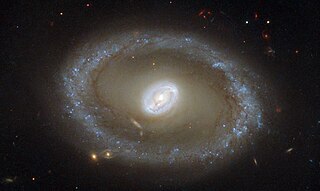
NGC 3081 is a barred lenticular ring galaxy in the constellation of Hydra. NGC 3081 is located about 85 million light-years away from Earth, which means, given its apparent dimensions, that NGC 3081 is approximately 60,000 light-years across. It is a type II Seyfert galaxy, characterised by its bright nucleus. It was discovered by William Herschel on 21 December 1786.
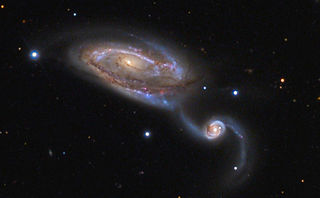
NGC 5395 is an interacting spiral galaxy located at a distance of 160 million light years, but receding away from the Earth at 3511 kilometers per second, in the constellation Canes Venatici. It was discovered by William Herschel on May 16, 1787. NGC 5395 and NGC 5394 are included in the Atlas of Peculiar Galaxies as Arp 84 in the category "Spiral galaxies with large high surface brightness companions".

NGC 600 is an emission-line galaxy in the constellation Cetus. It was discovered by William Herschel on 10 September 1785. The galaxy has a diameter of 70,000 light-years. It is also approximately 90 million light-years from the Milky Way.






















